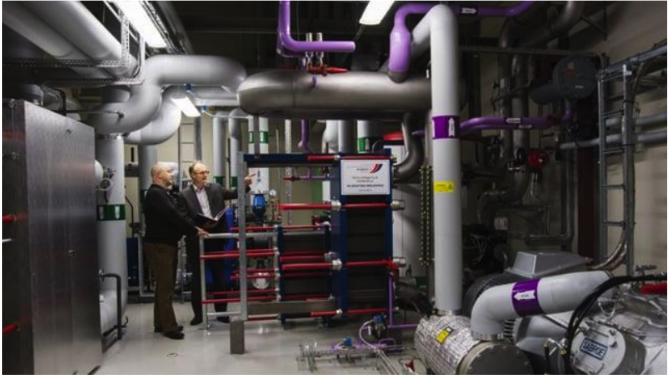Heat Pump Heat Exchangers
Efficient, Future-Proof Heating and Cooling Systems in Heat Pump Systems
The heat pump acts as part of a system that ‘pumps’ or moves heat from a cooler space to a hotter space, or vice versa, allowing industrial process and commercial facility designers capture waste heat for reuse or transfer it away from the building or process in question. These systems are thermally or electrically-driven that efficiently transfer heat from a source fluid to a system-side fluid in order to provide heating or cooling to a building or recover heat from industrial processes and natural heat sources. Heat pumps operate via a refrigeration or absorption cycle; therefore, they require condensers and evaporators, as well as a compressor/absorber, expansion valve, fans, pipes, control systems and other critical components for the transfer of heat from source to sink.
Typical heat sources for heat pump systems include: air, water, geothermal heat (from soil or water), or waste heat from industrial processes. Within a heat pump system, heat exchangers act as the condensers and evaporators, as well as desuperheaters, subcoolers, and intermediate units between refrigeration cycles to aid in transferring heat between the refrigerant and the source-side and sink-side fluids. Valutech supplies optimally- designed evaporators and condensers playing an integral role in the thermodynamic efficiency of heat pump systems, with careful selection and specification resulting in lower long-term operating costs both economically as well asin terms of resources consumed and emissions produced. Plate heat exchangers are an optimal solution for heat pump applications as their large surface area-to-size ratios and counter-current flow regimes allow them to achieve extremely close temperature approaches between refrigerants and source/sink fluids with a compact unit size. Alfa Laval plate heat exchangers are optimized to provide efficient heat transfer with traditional and natural refrigerants, reducing payback times and increasing energy and operating cost savings over unit lifetime.
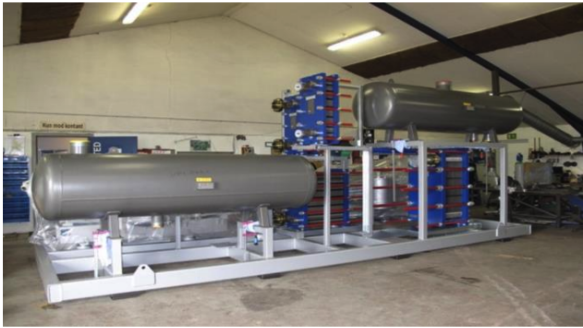 The Coefficient of Performance (COP) is a useful way to compare the efficiency of heating and cooling systems such as heat pumps, air conditioning systems, etc. The COP is the ratio of heating or cooling received to the work (energy) input for a system. Gas/oil boilers and electric boilers typically have COP values of around 0.85, and 1.0, respectively. On the other hand, heat pumps typically have COP values in the range of 3.0 – 4.0 since they move heat rather than generating it using electricity or fossil fuels. As a result, this increased efficiency reduces the energy input needed to provide an equivalent amount of heating, reducing operating costs and CO2 emissions for a given system. However, this can change based on operating conditions and system design; the COP of a heat pump decreases as the temperature difference between the heat source and the heat sink increases. This is because the compressor in the heat pump must raise the refrigerant to a higher pressure (and temperature) to overcome the greater temperature gap, increasing input energy without changing the amount of heat transferred. Since heat pumps are capable of transferring heat in both directions (from a source or to a sink), they are able to replace traditional heating and cooling systems that only provide a singular heating or cooling functionality.
The Coefficient of Performance (COP) is a useful way to compare the efficiency of heating and cooling systems such as heat pumps, air conditioning systems, etc. The COP is the ratio of heating or cooling received to the work (energy) input for a system. Gas/oil boilers and electric boilers typically have COP values of around 0.85, and 1.0, respectively. On the other hand, heat pumps typically have COP values in the range of 3.0 – 4.0 since they move heat rather than generating it using electricity or fossil fuels. As a result, this increased efficiency reduces the energy input needed to provide an equivalent amount of heating, reducing operating costs and CO2 emissions for a given system. However, this can change based on operating conditions and system design; the COP of a heat pump decreases as the temperature difference between the heat source and the heat sink increases. This is because the compressor in the heat pump must raise the refrigerant to a higher pressure (and temperature) to overcome the greater temperature gap, increasing input energy without changing the amount of heat transferred. Since heat pumps are capable of transferring heat in both directions (from a source or to a sink), they are able to replace traditional heating and cooling systems that only provide a singular heating or cooling functionality. Therefore, heat pump systems can replace a combination of boilers and air-conditioners or chillers in applications ranging in scale from a single residence to large-scale industrial manufacturing plants. Current estimates of global energy consumption by source have determined that the heating and cooling of buildings accounts for around 24%, with up to 50% of total worldwide energy consumption coming from general heating and cooling for all applications. Therefore, replacing electrically-powered or gas/oil boilers with heat pumps to provide heating for residential, commercial, and industrial applications provides the ability to control system temperatures with a significant increase in efficiency. The transition to using heat pumps systems, especially in conjunction with environmentally friendly, low-GWP (Global Warming Potential) refrigerants, is critical for manufacturing industries and HVAC system designers aiming to meet emissions targets and place themselves on the pathway for their industries to contribute to broader environmental sustainability on a global level.
Therefore, heat pump systems can replace a combination of boilers and air-conditioners or chillers in applications ranging in scale from a single residence to large-scale industrial manufacturing plants. Current estimates of global energy consumption by source have determined that the heating and cooling of buildings accounts for around 24%, with up to 50% of total worldwide energy consumption coming from general heating and cooling for all applications. Therefore, replacing electrically-powered or gas/oil boilers with heat pumps to provide heating for residential, commercial, and industrial applications provides the ability to control system temperatures with a significant increase in efficiency. The transition to using heat pumps systems, especially in conjunction with environmentally friendly, low-GWP (Global Warming Potential) refrigerants, is critical for manufacturing industries and HVAC system designers aiming to meet emissions targets and place themselves on the pathway for their industries to contribute to broader environmental sustainability on a global level.
Alfa Laval plate heat exchangers supplied by Valutech are an optimal choice for sustainable long-term operation of heat pump systems on the basis of their efficient plate patterns, high heat transfer area-to-unit volume ratios, and high temperature coverage with extreme pressure fatigue resistance to provide the following benefits:
- Low refrigerant charges to reduce system dependency on potentially expensive or dangerous refrigerants,
- Close temperature approaches with minimal pressure losses to keep pumps small and save space,
- Optimized to work with natural refrigerants such as ammonia, carbon dioxide, or hydrocarbons to make the system future-proof,
- A reliable supplier of a globally-trusted brand with a complete support network and proven performance in worldwide applications of all scales.
These capabilities allow Alfa Laval plate heat exchangers to effectively operate as evaporators and condensers in heat pump systems of all scales; Valutech supplies both standard and custom solutions using the following styles of plate heat exchangers with unique characteristics to suit virtually all industrial and commercial heat pump applications:
Copper brazed heat exchangers are exceptionally compact relative to their heat transfer capabilities and are a standard choice for evaporating and condensing in commercial and small-capacity industrial heat pumps as they work with most types of refrigerants, including low-GWP variants such as CO2 and hydrocarbons. Alfa Laval’s AlfaNova line of stainless-steel fusion bonded heat exchangers is highly suited to take advantage of ammonia as a natural refrigerant with low-GWP potential and high efficiency due to its 100% stainless steel construction, and is the sole offering of its kind on the market. Brazed and bonded heat exchangers can also be applied in urban residential applications to reduce CO2 on city-wide scales. For medium to large heat pump applications, Alfa Laval gasketed plate-and-frame, as well as Compabloc® welded plate heat exchangers excel as condensers and evaporators due to their short flow paths and large cross-flow areas to promote low pressure drops with high thermal efficiency. Compabloc® is also available with two-pass arrangements that allow for subcooling or gas-liquid separation for vapours containing non-condensable gases, making them highly customizable for industrial processes.

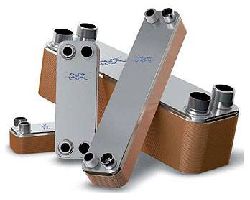
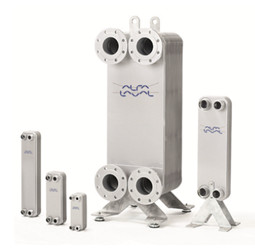
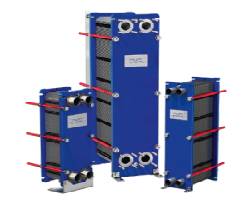
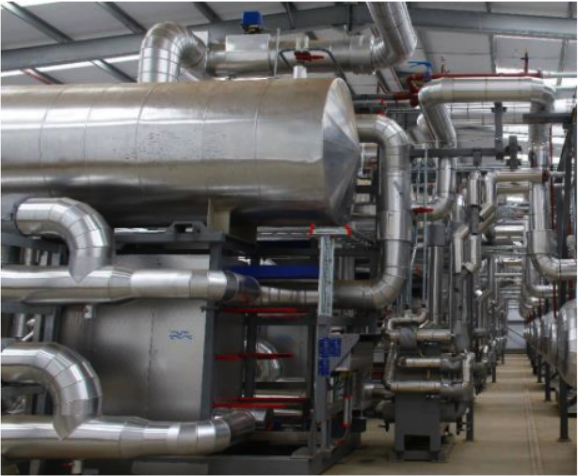 Heat pumps for industrial settings are designed for high-capacity applications and often require intensive engineering to specify for a certain process. As heat pumps are capable of efficiently moving and re-using process heat, they are suited to supplying process heating via existing waste streams or ambient heat in settings where emission reductions are important. Chillers or condensers in industrial processes produce waste heat that can be used for process fluid heating via heat pumps in the pharmaceutical, chemical, food & beverage, pulp & paper, metal processing, and many other industries. The ability of heat pumps to pull heat from, or reject heat to, a reservoir has the additional benefit of reducing loads on chillers while allowing for precise control of temperature differentials between condensers and evaporators in industrial applications. Waste heat from industrial processes can be reused via heat pump systems to boost process efficiency and reduce dependency on external energy sources. Heat is moved from waste streams to other unit operations that can take advantage of the heating or cooling afforded by the system instead of requiring additional energy input. Industrial processes use a relatively wider variety of heat sources/sinks as well as process fluids relative to commercial and residential heat pump systems, often at more extreme temperatures and pressures.
Heat pumps for industrial settings are designed for high-capacity applications and often require intensive engineering to specify for a certain process. As heat pumps are capable of efficiently moving and re-using process heat, they are suited to supplying process heating via existing waste streams or ambient heat in settings where emission reductions are important. Chillers or condensers in industrial processes produce waste heat that can be used for process fluid heating via heat pumps in the pharmaceutical, chemical, food & beverage, pulp & paper, metal processing, and many other industries. The ability of heat pumps to pull heat from, or reject heat to, a reservoir has the additional benefit of reducing loads on chillers while allowing for precise control of temperature differentials between condensers and evaporators in industrial applications. Waste heat from industrial processes can be reused via heat pump systems to boost process efficiency and reduce dependency on external energy sources. Heat is moved from waste streams to other unit operations that can take advantage of the heating or cooling afforded by the system instead of requiring additional energy input. Industrial processes use a relatively wider variety of heat sources/sinks as well as process fluids relative to commercial and residential heat pump systems, often at more extreme temperatures and pressures.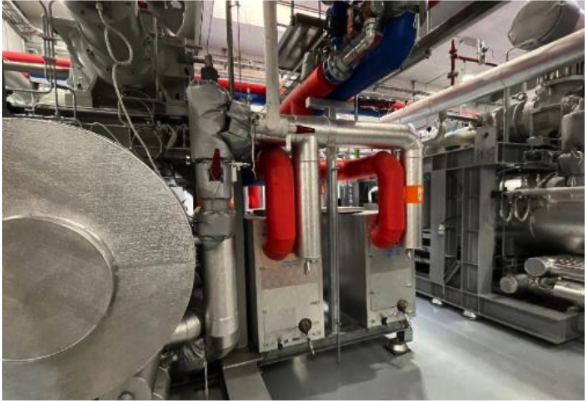 condensate streams and transfer that heat to a glycol mixture passing through the condenser. District heating networks ensure as little heat is wasted as possible by supplying heat from existing natural or industrial heat sources to nearby industrial operations, as well as residences and pools. Heat pumps are crucial in modern district heating systems that provide heat for local processes from industrial sources including sewage/wastewater facilities and data centres, as well as from nearby bodies of water such as rivers, seawater, etc., aquifers, or other geothermal sources.
condensate streams and transfer that heat to a glycol mixture passing through the condenser. District heating networks ensure as little heat is wasted as possible by supplying heat from existing natural or industrial heat sources to nearby industrial operations, as well as residences and pools. Heat pumps are crucial in modern district heating systems that provide heat for local processes from industrial sources including sewage/wastewater facilities and data centres, as well as from nearby bodies of water such as rivers, seawater, etc., aquifers, or other geothermal sources.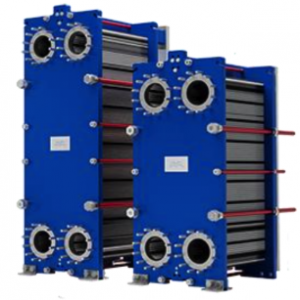
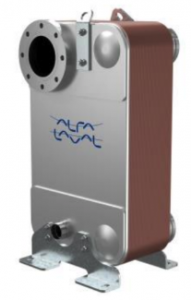 Future trends in refrigerant selection will subsequently influence the design of heat exchangers used as condensers and evaporators in heat pump systems. As low-density refrigerants become the norm, heat exchanger models will require intelligently-designed distribution systems to ensure even distribution of refrigerants across plate surfaces. This is due to the fact that low-density refrigerants will by necessity need to flow at higher volumetric flow rates to provide equivalent heat transfer performance with respect to high-density refrigerants; larger port sizes for gas-phase refrigerant inlets will also be needed to compensate. Models such as the Alfa Laval AC900, as seen on the right, are specifically designed with the above-mentioned features to work in air conditioning and refrigeration applications as evaporators and condensers in chillers and heat pumps.
Future trends in refrigerant selection will subsequently influence the design of heat exchangers used as condensers and evaporators in heat pump systems. As low-density refrigerants become the norm, heat exchanger models will require intelligently-designed distribution systems to ensure even distribution of refrigerants across plate surfaces. This is due to the fact that low-density refrigerants will by necessity need to flow at higher volumetric flow rates to provide equivalent heat transfer performance with respect to high-density refrigerants; larger port sizes for gas-phase refrigerant inlets will also be needed to compensate. Models such as the Alfa Laval AC900, as seen on the right, are specifically designed with the above-mentioned features to work in air conditioning and refrigeration applications as evaporators and condensers in chillers and heat pumps. As urban planners and commercial building designers strive to become more sustainable and reduce energy costs, heat pumps are increasingly being turned to as a solution. As heat pumps efficiency transfer heat from a source, they reduce the strain on existing high-energy-consumption heating and cooling systems. Businesses often combine electric boilers with heat pumps to supplement heat during peak periods or when outside temperatures are too low to operate a heat pump efficiently. At the same time, waste heat can be recovered from buildings and transportation systems to improve operational efficiency via external energy storage. By using water or other materials to store excess heat generated in off-peak times, energy can be reused during peak periods to reduce overall energy consumption. When used on a wide scale, such systems reduce energy requirements and on grid usage demands over large areas such as urban centres.
As urban planners and commercial building designers strive to become more sustainable and reduce energy costs, heat pumps are increasingly being turned to as a solution. As heat pumps efficiency transfer heat from a source, they reduce the strain on existing high-energy-consumption heating and cooling systems. Businesses often combine electric boilers with heat pumps to supplement heat during peak periods or when outside temperatures are too low to operate a heat pump efficiently. At the same time, waste heat can be recovered from buildings and transportation systems to improve operational efficiency via external energy storage. By using water or other materials to store excess heat generated in off-peak times, energy can be reused during peak periods to reduce overall energy consumption. When used on a wide scale, such systems reduce energy requirements and on grid usage demands over large areas such as urban centres.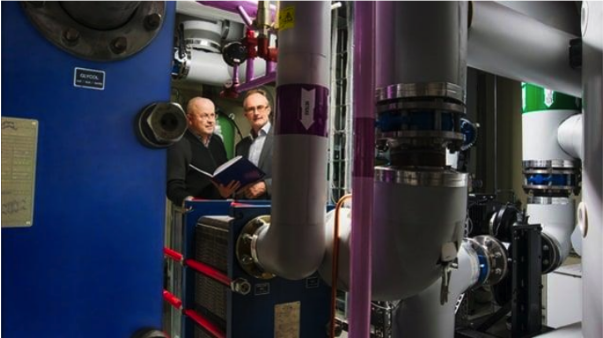 The use of efficient heat exchangers within heat pump systems in commercial applications lowers heating and cooling costs and allows for electricity-based heating from renewable energy sources while providing the flexibility to reduce dependencies on traditional commercial boiler and air conditioning systems. Replacing boilers in residential and commercial buildings on a global scale would amount to an estimated 230 TW⋅h in energy savings annually; the selection of the right plate heat exchangers for heat pump applications will therefore allow consumers and commercial facility operators to reap the benefits of reduced operating costs with relatively short payback times while contributing positively to local emissions and sustainability goals. Alfa Laval heat exchangers have advanced design features, such as integrated subcooling and state-of-the-art sealing systems to lead the commercial heat pump heat exchanger market.
The use of efficient heat exchangers within heat pump systems in commercial applications lowers heating and cooling costs and allows for electricity-based heating from renewable energy sources while providing the flexibility to reduce dependencies on traditional commercial boiler and air conditioning systems. Replacing boilers in residential and commercial buildings on a global scale would amount to an estimated 230 TW⋅h in energy savings annually; the selection of the right plate heat exchangers for heat pump applications will therefore allow consumers and commercial facility operators to reap the benefits of reduced operating costs with relatively short payback times while contributing positively to local emissions and sustainability goals. Alfa Laval heat exchangers have advanced design features, such as integrated subcooling and state-of-the-art sealing systems to lead the commercial heat pump heat exchanger market. 